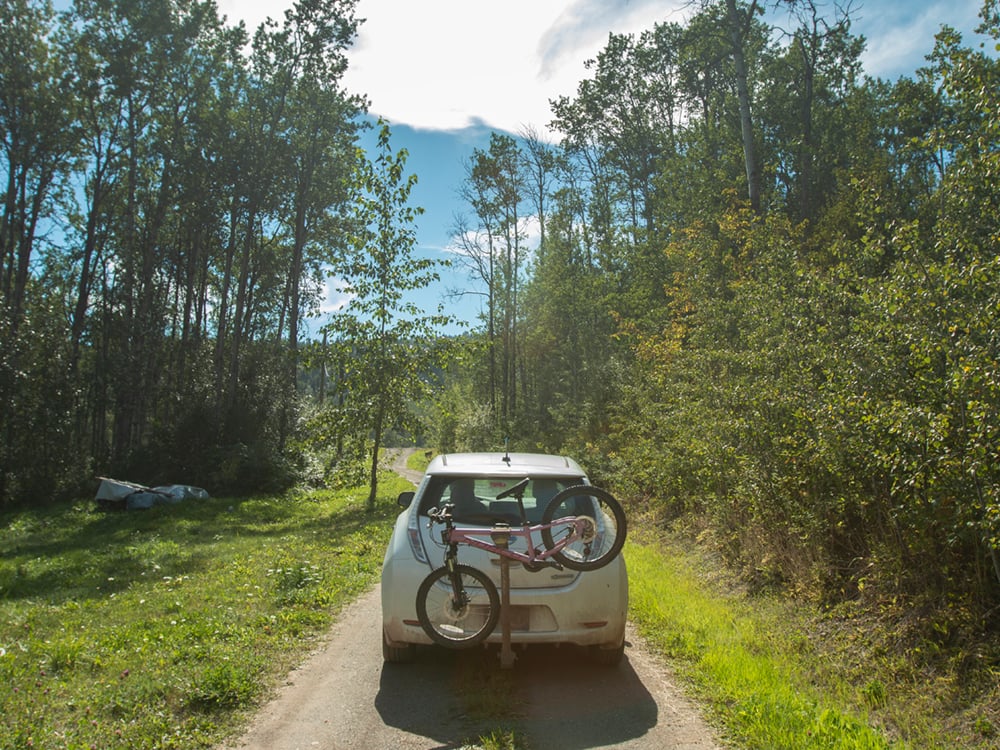One frigid night in January 2021, I sat in my car next to Highway 16 in Smithers, B.C.
It was the wee hours of the morning and I’d occasionally get out, stomp my feet and take photos of the deserted highway. I’d rolled out of bed at 1 a.m. to watch a turbine destined for Site C dam construction pass through my northern community and, hours later, my toes were beginning to numb.
Like the rest of the project, the 170-tonne turbine was behind schedule.
As the thermometer dropped below -20 C, I let the car run, trying to keep warm. It wasn’t until the procession had (finally) passed through town and I was halfway home, at about 4 a.m., that I realized my mistake.
Several kilometres from my bed, the range on my dashboard was flashing zero.
For the most part, I love our Nissan Leaf. We bought it early 2020, after my husband convinced me that an electric vehicle was, indeed, within our price range. In fact, the EV was almost a straight exchange with our older SUV — plus a little extra for taxes and $1,500 for the dealer to ship it 1,200 kilometres from Vancouver Island to Smithers.
The car is quiet, peppy and fun to drive. It hasn’t seen the inside of a mechanic’s since we bought it and, best of all, we barely give gas prices a passing glance.
But it wouldn’t work for everyone.
Former BC Greens leader Andrew Weaver appeared oblivious to that fact when he posted a tweet apparently aimed at shaming Victoria politician Ben Isitt for owning an “old, gas guzzling, silver Honda CRV.”
The responses to this cringey tweet — and the resulting discussion about EVs — caught my attention.
In the replies, Weaver proselytized that “EVs are affordable” and that “nobody should own a gas powered vehicle if they can get their hands on an EV.”
EVs are affordable. But more importantly, E-bikes are totally affordable as is public transportation. I would never shame anyone for the situation they are in. But if you want to put yourself out as a champion of climate action, you need to be accountable for your own behaviour!
— Andrew Weaver (@AJWVictoriaBC) September 1, 2022
Again, this is incorrect as you have to address up front capital vs ongoing operating costs. Nobody should own a gas powered vehicle if they can get their hands on an EV. And you can import cheap second hand ones from the US.
— Andrew Weaver (@AJWVictoriaBC) September 1, 2022
And he revealed that he’s hopelessly out of touch with much of the province — not to mention basic human empathy.
Setting aside, for a moment, the immense privilege of owning a vehicle at all (average new-vehicle prices topped $50,000 earlier this year, while used vehicles jumped by 50 per cent to an average $35,000), let’s assume Weaver’s definition of “affordable” is a Nissan Leaf. An older, used model — if you can find one — will set you back around $20,000.
The more you pay, the better your range — a significant part of the cost is battery power, something that has improved with newer vehicles.
In summer, our 2014 Leaf gets about 120 kilometres of range. In winter, closer to 100 kilometres. The projected distance left in a battery fluctuates wildly based on speed and terrain. It decreases rapidly on the way up our mountain road, for example, or once we hit the highway.
We can get a handful of trips to town — the vast majority of our driving — on a single charge. If I’m feeling adventurous, I’ll take it to the next town over. It’s the perfect commuter for our household and we juggle schedules to use it as much as possible.
But the fact is, electric vehicles deemed affordable also have their limits — especially when you live in an area with cold temperatures and long distances.
Our trick to making it work? The “old, gas guzzling” pickup that, as much as possible, remains parked in our driveway, waiting for the day we need two vehicles or a load of firewood. It’s our road trip vehicle, our camping vehicle and my work vehicle when reporting takes me out on remote resource roads.
It’s what works for our family. Other families do it differently.
We have friends who have invested the $40,000 it takes to own a newer electric vehicle that will reliably get you from charger to charger on northern highways (assuming, of course, they work when you get there).
We have other friends who make do with a single, do-it-all combustion-engine vehicle that they plan on driving into the ground.
There’s a clear argument to be made that the greenest vehicle is the one you don’t buy. According to one Reuters study, you need to drive 25,000 to 30,000 kilometres — about a half dozen laps around the province — before the emissions saved by your new EV outstrip the emissions from manufacturing it.
More and more, people we know are investing in e-bikes, which are great — but a challenge when hauling kids and groceries up snowy rural roads. And don’t even get me started on the region’s patchy bus service and unreliable passenger trains.
If you’re among the almost two-thirds of B.C. residents who live in Metro Vancouver or another major centre, maybe you can get by with only using transit, bikes or an inexpensive EV — hooray! I wish for everyone the joy of never having to pull into a gas station ever again.
But if it doesn’t work for you, that’s OK, too.
My point here isn’t to split hairs over low-carbon transportation options. It’s simply to say there is no silver bullet solution that will work for everyone. Our responses to climate change are messy, imperfect and as necessarily varied and unique as we are.
Maybe you live in the city and walk or bus everywhere.
Maybe you live in the country and grow your own food.
Maybe you’re reading this in your brand-new passive-solar house or an efficient, high-density housing complex.
To its credit, the provincial government has been working to increase the number of charging stations in northern B.C., making EV ownership more attainable in the North, and increased its rebates for new vehicles last month.
But the myriad variables when it comes to lowering our carbon emissions are complex. Take, for example, the controversial Site C project that almost left me stranded that cold January evening — justified, in part, by the shift to EVs, yet itself plagued with environmental issues.
On that cold January night, I weighed the variables.
I thought about pulling over and calling my husband, who was at home with our sleeping child. I thought about pulling into my neighbours’ driveway, trudging the remaining kilometre home and returning the next day with my charger.
Instead, I gripped the steering wheel tighter, leaned in and made the final push home, coasting into our driveway on what must have been the voltage sparked by my range anxiety.
It’s not the only time I’ve experienced it and likely won’t be the last. That’s OK. The inconvenience of a lower-cost EV is a risk I’m prepared to accept.
But if it doesn’t work for you and you’re approaching climate solutions another way, that’s OK, too. ![]()
Read more: Transportation, Science + Tech, Environment
















Tyee Commenting Guidelines
Comments that violate guidelines risk being deleted, and violations may result in a temporary or permanent user ban. Maintain the spirit of good conversation to stay in the discussion.
*Please note The Tyee is not a forum for spreading misinformation about COVID-19, denying its existence or minimizing its risk to public health.
Do:
Do not: